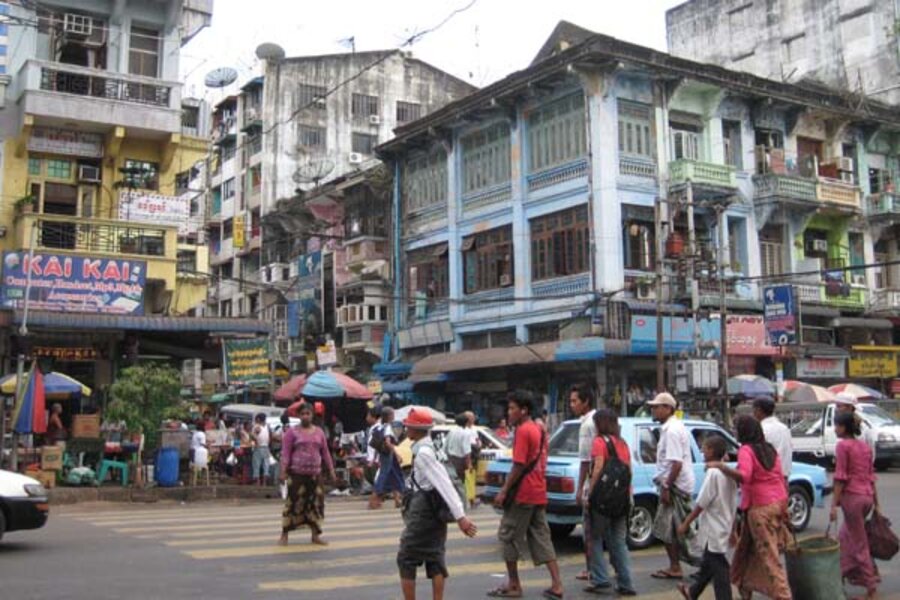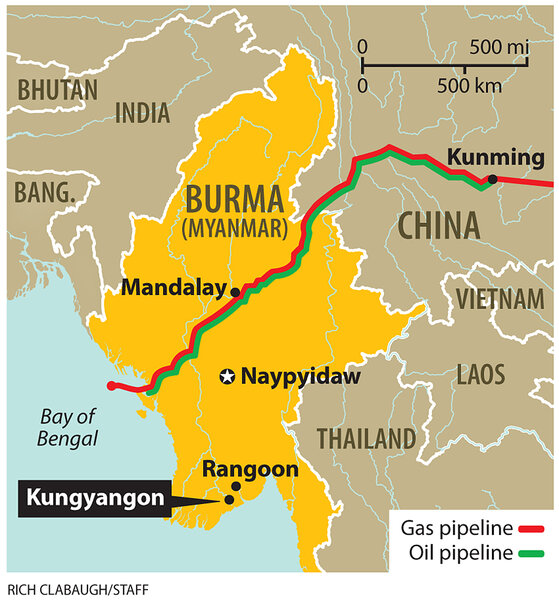What stigma? Burma (Myanmar) draws energy-hungry neighbors
Loading...
| Kungyangon, Burma
Six months ago, a construction crew showed up in this sleepy Burmese backwater. Villagers watched the crew put down a black pipeline under their rice fields, on its way north to power-hungry Rangoon (Yangon), the old capital.
The pipeline opened June 12 to acclaim in Burma’s largest city, where households are lucky to get six hours of electricity a day. For villagers living on the pipeline route, the benefits are less clear. At a local store, the only power comes from an old car battery hooked up to a single bulb. Nobody has electricity at home. “The gas is not for us,” says a farmer.
But the villagers were lucky in one respect: Nobody had to move off their land to make way for the pipeline.
Elsewhere in military-ruled Burma (Myanmar), authorities have seized land for energy projects that are increasingly attractive to Asian oil companies unhindered by recent Western sanctions. When the wells are turned on and the energy is exported to richer countries, local communities are often left landless and in the dark.
The pipeline to Rangoon will give more Burmese citizens access to a gas field operated by France-based Total and US-based Chevron that, since 1998, had already been supplying 30 percent of Thailand’s electricity supply via a separate pipeline. Not only has the bulk of gas been exported, but Total and Chevron have been dogged by allegations of human rights abuses over the pipeline's $1.3 billion construction. In 2005, the companies paid out-of-court settlements to plaintiffs in separate lawsuits alleging complicity in the abuses.
But that project pales in comparison to a new Asian-backed pipeline project that is much bigger and potentially more disruptive than any predecessor, according to US- and Thailand-based activists.
Chinese, South Korean, and Indian energy companies are investing in a gas terminal and an oil tanker dock at the Shwe Gas field in western Arakan state, from where two pipelines will be built to transport Burmese natural gas and imported crude oil to southern China. Construction began in late 2009 and is expected to complete in 2013.
About 100 families have already lost their land to developers, who have paid them little or no compensation, says Wong Aung, a coordinator for the Shwe Gas Movement in Thailand, which opposes the project. Instead they are left to search for vacant land nearby where they can resettle. Many more living inland on the pipeline route face the risk of land confiscation and forced labor by security forces, Wong Aung warns.
"We’d like the companies to suspend the project until we have a democratically elected government in Burma where people can genuinely participate,” he says.
A highly prized pipeline
The Shwe Gas field is close to the border with Bangladesh and is operated by South Korean Daewoo International. The discovery in 2004 of large offshore reserves attracted India’s government, which proposed its own pipeline via Bangladesh. This plan bogged down over concerns by Indian officials that Bangladesh wasn’t a secure route, says Marie Lall, an associate fellow at Chatham House in London who has studied the project.
As India dithered, China swooped in with its proposal of twin pipelines in 2007. The first will transport gas from Daewoo-operated gas fields. The second is designed to carry some 442,000 barrels a day of crude oil, giving China an alternative route for cargoes from Africa and the Middle East, which must travel by sea through the congested Malacca Straits. Security analysts say Beijing wants to lessen its dependence on this route for its essential energy supplies.
The pipelines cross some 600 miles of Burmese territory, including mountainous zones and areas patrolled by armed militia. By contrast, the Burmese section of the Total’s onshore pipeline is 40 miles.
“It’s going to be the most complicated and hazardous terrain for a pipeline that China has ever encountered,” says Ms. Lall.
Activists gear up
In recent years, the International Labor Organization (ILO) has criticized Burma over the practice of forced labor by the military, government agencies, and private companies. Activists say local residents are often coerced to work unpaid on massive infrastructure projects such as road building and energy pipelines.
Steve Marshall, an ILO official in Burma, says he has proposed to the government that it informs local authorities and local communities along the pipeline route that such abuses won’t be tolerated. He says he has also discussed labor issues with Daewoo, the gas operator, but hasn’t given any direct advice on their project.
For activists who successfully convinced major Western brands like Nike and Pepsi to boycott the country in the late-1990s, and who shined a spotlight on the ethics of Western oil firms operating in the country, the onrush of Asian energy companies poses new challenges. Burma’s human rights record seems unlikely to deter China National Petroleum Corporation, the pipeline operator.
Activists say they are lobbying overseas investors and other stakeholders in Asia, Europe, and the US to insist on accountability in the project and ensure that the rights of ordinary Burmese are respected.
“There are creative ways to get companies to do the right thing,” says Matthew Smith, a spokesperson for Earthrights International, the Washington-based group that sued Total and Unocal on behalf of Burmese victims.
Because of constraints placed on foreign reporters in Burma, the correspondent could not be named.
Related:






